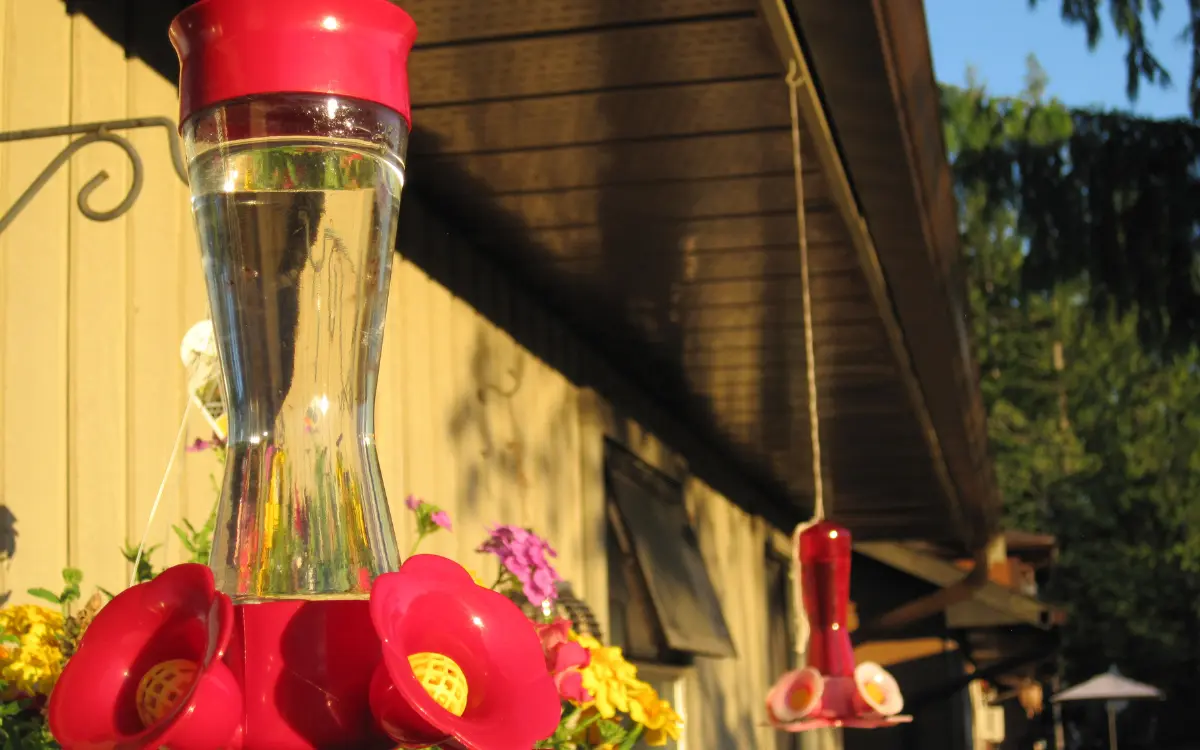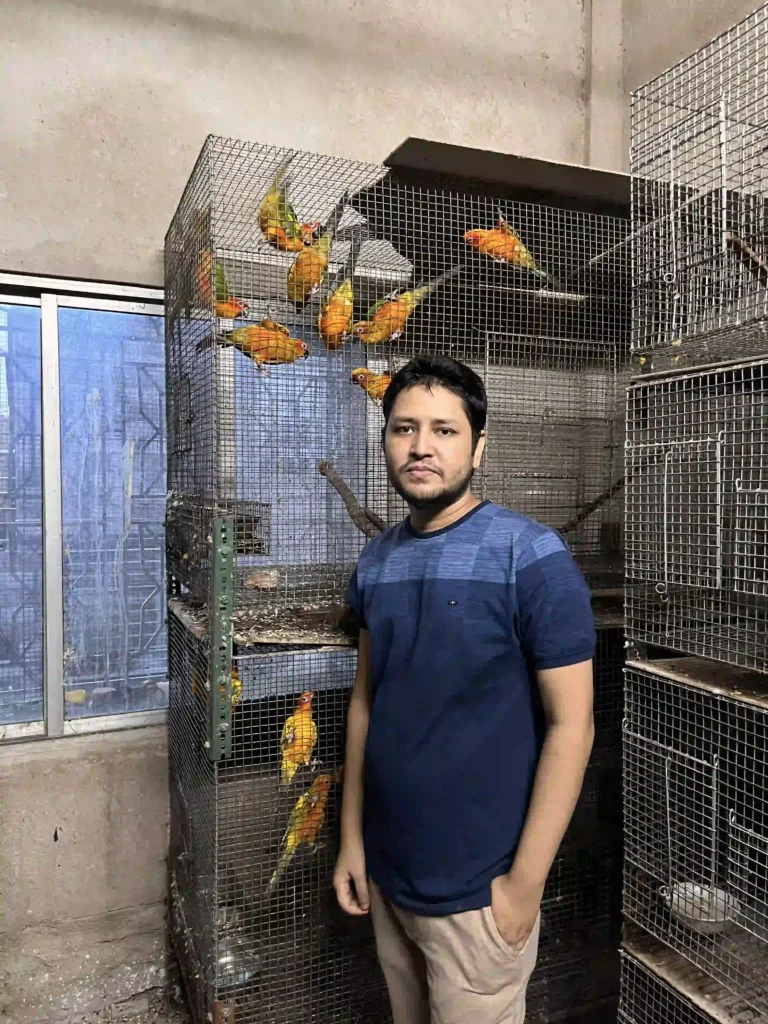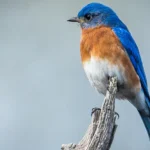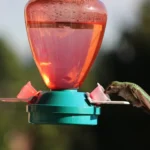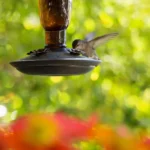Choosing the right spot to hang a hummingbird feeder is essential for attracting these delicate birds and ensuring their safety.
Proper placement not only draws more hummingbirds to your yard but also protects them from predators, harsh weather, and competition with other birds.
With a few thoughtful considerations, you can create a welcoming environment where hummingbirds can feed and thrive.
Here’s a list of potential locations for hanging a hummingbird feeder:
- Near Flower Gardens – Close to nectar-producing flowers that naturally attract hummingbirds.
- Under a Tree – Provides shade and a natural environment while keeping nectar fresh.
- On a Patio or Deck – Perfect for birdwatching from home, but in a quiet corner.
- Near a Window (with decals) – Allows great views while ensuring birds’ safety from collisions.
- Under Eaves or Awnings – Sheltered from direct sun and rain, keeping the nectar fresh.
- On a Balcony – Use railing hooks or suction cups to hang feeders in urban spaces.
- Away from High-Traffic Areas – Keep feeders away from doors, walkways, or busy patios.
- In Open Spaces – Allows birds to see potential threats and feed without feeling cornered.
- Far from Regular Bird Feeders – Maintain a peaceful feeding space by keeping at least 10-15 feet between feeders.
- Next to Bright Flowers – Increases visibility and attractiveness by mimicking natural nectar sources.
Ideal Places to Hang a Hummingbird Feeder

When choosing a spot to hang your hummingbird feeder, consider locations that mimic their natural feeding environments.
Hanging a feeder near a garden or flowering plants is ideal, as hummingbirds are naturally drawn to areas with abundant nectar sources.
Positioning the feeder near vibrant flowers can increase the likelihood of visits, as it blends with their usual foraging habits.
Shade is another important factor. Direct sunlight can quickly spoil the nectar, especially during hot summer days. To prevent the nectar from fermenting, choose a spot that offers partial shade throughout the day.
Areas under trees, awnings, or the eaves of your home can provide enough protection while still allowing the feeder to remain visible.
Hummingbirds are tiny and can be vulnerable to predators, so place the feeder in an area where they feel safe. Avoid hanging feeders too close to bushes or low branches, where cats or other predators could easily hide.
Instead, opt for open spaces with good visibility, allowing the birds to see any potential threats while they feed. By selecting a safe, shaded, and naturally inviting spot, you’ll create an environment that encourages hummingbirds to return regularly.
Where Should You Not Hang a Hummingbird Feeder
Certain locations are less than ideal for hanging a hummingbird feeder, as they can disrupt the birds or put them in harm’s way. High-traffic areas like doorways, walkways, or near busy patios should be avoided.
Hummingbirds are skittish and prefer quiet, undisturbed spaces. Constant movement from people or pets could deter them from visiting your feeder.
It’s also important to avoid areas exposed to strong winds or prolonged direct sunlight. Strong winds can make it difficult for the birds to feed and may spill the nectar, while direct sun causes the nectar to spoil faster.
This makes the feeder less appealing and potentially harmful for the birds. Opt for a shaded spot with some wind protection to keep the feeder stable and the nectar fresh.
Lastly, be cautious about hanging feeders near large windows without bird decals or deterrents. Hummingbirds can mistake clear glass for open space, leading to dangerous collisions. If you must place the feeder near a window, ensure there are visible markings to help the birds avoid accidents.
Can I Hang a Hummingbird Feeder in a Tree?
Hanging a hummingbird feeder in a tree can be a good option, but it comes with both advantages and challenges. One of the main benefits is that trees provide natural shade, protecting the nectar from direct sunlight and keeping it fresh for longer.
Trees also create a natural environment, attracting hummingbirds who feel comfortable feeding near familiar surroundings.
However, there are some potential downsides. Hanging the feeder too close to dense branches may make it difficult for birds to spot.
Additionally, trees can be a hiding place for predators like cats or larger birds, putting the hummingbirds at risk. Pests such as ants or bees may also be more common in tree areas, so using ant moats or bee guards is a good precaution.
To ensure the feeder remains visible and safe, hang it from a thin branch or use an extended hook to position it away from the trunk and dense foliage.
This allows hummingbirds to easily see and access the feeder, while giving them open space to fly away if they sense danger. By taking these steps, you can enjoy the benefits of hanging a feeder in a tree while minimizing the risks.
Where to Hang a Hummingbird Feeder Outside
When selecting an outdoor spot for your hummingbird feeder, choose locations that offer both comfort and visibility for the birds.
One great option is to hang the feeder under an eave, where it will be sheltered from harsh weather, including heavy rain and direct sun. This helps keep the nectar fresh while also giving the birds a secure, shady spot to feed.
If you have a patio or deck, hanging the feeder nearby can make for easy birdwatching while still giving the hummingbirds the peace they need.
Just be sure it’s in a quieter corner away from constant foot traffic. The garden is another excellent location, especially if it’s filled with colorful flowers that naturally attract hummingbirds.
Regardless of where you hang the feeder, ensure that the area gets partial shade throughout the day to prevent the nectar from spoiling. However, it’s also important that the feeder remains visible to the birds—too much foliage or obstruction can make it harder for them to find.
With the right balance of shade, protection, and visibility, your feeder will be an inviting spot for hummingbirds to visit regularly.
How to Hang a Hummingbird Feeder on a Balcony
Hanging a hummingbird feeder on a balcony can be a great way to attract these beautiful birds, even in urban settings.
There are several creative methods for placing feeders in limited balcony spaces.
Railing hooks are one of the easiest options—these hooks clamp onto the balcony railing and can hold your feeder securely without the need for drilling or permanent fixtures. Another option is using suction cup mounts, which allow you to attach the feeder directly to windows or glass doors, giving hummingbirds easy access.
To attract birds to your balcony, especially in urban areas where natural habitats might be scarce, add potted flowers or plants that produce nectar, such as trumpet vines or fuchsia, to create a welcoming environment.
Bright-colored flowers can act as natural beacons for hummingbirds, drawing them in. Additionally, positioning your feeder in a quiet corner, away from noise and movement, will make the birds feel more comfortable.
For city dwellers, patience is key. Hummingbirds might take a little longer to discover balcony feeders, but once they do, they’re likely to return regularly. With the right setup, even a small balcony can become a hummingbird haven.
Can You Put a Hummingbird Feeder Next to a Bird Feeder?
While it may seem convenient to place a hummingbird feeder next to a regular bird feeder, there are both benefits and potential downsides to consider.
One benefit is that having both feeders in close proximity can attract a wider variety of birds, making your yard a more lively and diverse birdwatching space. Hummingbirds are curious creatures, and they might be intrigued by the activity around the regular feeder.
However, placing the feeders too close together can lead to issues. Larger birds that visit the regular feeder, such as finches or sparrows, can scare away hummingbirds, which are more timid and sensitive to crowding.
Additionally, larger birds may dominate the feeding area, leaving little opportunity for hummingbirds to access their feeder.
To avoid these issues, it’s best to keep some distance between your hummingbird feeder and regular bird feeder. A separation of at least 10-15 feet is ideal, giving hummingbirds their own quiet space to feed without the risk of being disturbed.
This way, you can enjoy the presence of both types of birds while ensuring each gets the chance to feed comfortably.
Multiple Hummingbird Feeder Placement
Placing multiple hummingbird feeders in your yard can be a great way to attract more birds while reducing territorial disputes.
Hummingbirds, especially males, are known to be highly territorial and will often guard feeders aggressively, chasing other birds away.
By offering several feeders, you can minimize this competition and give multiple birds the opportunity to feed peacefully.
To maximize the benefits, space the feeders far enough apart so that a dominant bird cannot easily control all of them. Ideally, place the feeders at least 10 to 12 feet apart and, if possible, out of each other’s direct line of sight. This helps prevent territorial birds from monopolizing all the feeders and allows more timid hummingbirds to feed undisturbed.
Additionally, hanging feeders in different areas of the yard, such as near flowers, under eaves, or from trees, creates a diverse feeding environment. By offering multiple feeding options with adequate spacing, you encourage more hummingbirds to visit, making your yard a hummingbird-friendly haven.
How Long Does It Take for Hummingbirds to Come to a Feeder?
Hummingbirds can take anywhere from a few hours to a couple of weeks to discover a new feeder, depending on your location and the birds’ activity in your area.
If hummingbirds are already nearby, they may find the feeder quickly. However, if you’re in a new area or setting up a feeder for the first time, it might take a bit longer for them to notice.
To encourage quicker discovery, place the feeder near bright flowers or in a visible spot that’s easy for birds to see.
Red flowers or red ribbons tied around the feeder can help attract them, as hummingbirds are drawn to bright colors.
Regularly changing the nectar and keeping it fresh will also increase the chances of hummingbirds visiting and returning to the feeder.

